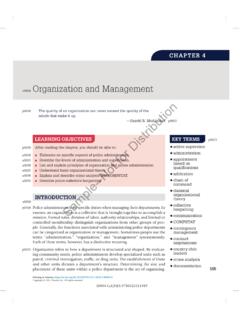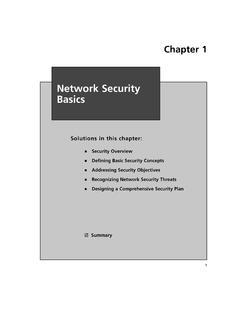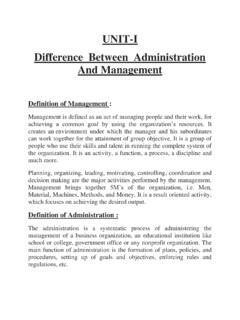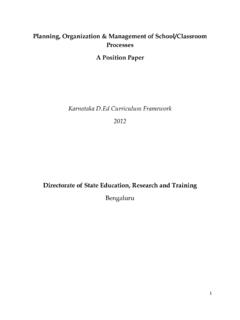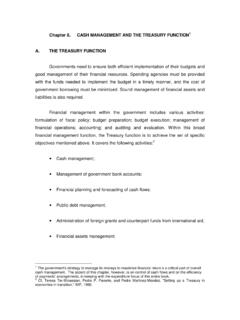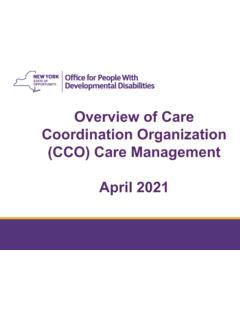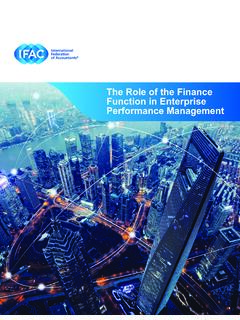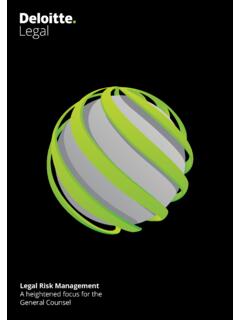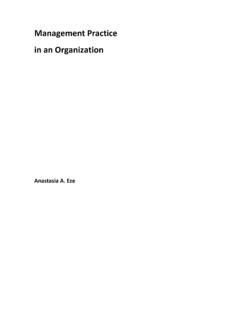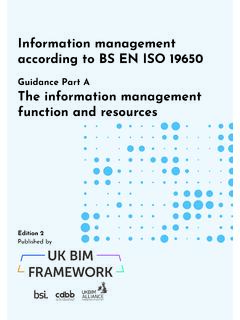Transcription of Chapter 4 - Organization and Management
1 Policing in America. 2014 Elsevier Inc. All rights reading the Chapter , you should be able to: n Elaborate on specific aspects of police administration. n Describe the levels of administration and supervision. n List and explain principles of Organization and police administration. n Understand basic organizational theory. n Explain and describe crime analysis and COMPSTAT. n Describe police collective 4 KEY TERMSp0055 n active supervisor n administration n appointment based on qualifications n arbitration n chain of command n classical organizational theory n collective bargaining n communication n COMPSTAT n contingency Management n contract negotiations n country club leaders n crime analysis n documentationLEARNING OBJECTIVESO rganization and ManagementThe quality of an Organization can never exceed the quality of the minds that make it up.
2 Harold R. McAlindonc0004p0010p0015 INTRODUCTIONP olice administrators have specific duties when managing their departments. In essence, an Organization is a collective that is brought together to accomplish a mission. Formal rules, division of labor, authority relationships, and limited or controlled membership distinguish organizations from other groups of peo-ple. Generally, the functions associated with administering police departments can be categorized as Organization or Management . Sometimes people use the terms administration, Organization , and Management synonymously.
3 Each of these terms, however, has a distinctive refers to how a department is structured and shaped. By evaluat-ing community needs, police administrators develop specialized units such as patrol, criminal investigation, traffic, or drug units. The establishment of these and other units dictates a department s structure. Determining the size and placement of these units within a police department is the act of organizing. s0010p0310p0315 Sample--Not for Distribution166 Chapter 4: Organization and Management10004-GAINES-9780323311489 n employee benefits n equity theory n expectancy theory n fact finding n general orders n hierarchy n hierarchy of needs n impasse resolution n impoverished leaders n innovative supervisorThe police administrator must organize the department in the way that most efficiently balances competing community needs and interests.
4 For example, if a community is fairly small and is not experiencing a significant drug prob-lem, it would be a waste of personnel to create a drug unit. As a department grows in size, Organization becomes more important, because additional spe-cialized units are added to the department. Organization is not critical in a small department consisting of five officers, but it is important to the New York City Police Department, which has almost 40,000 officers. Police executives in large departments must take great care in the manner in which they structure their is the processes that occur within the structure.
5 Police admin-istrators and supervisors must constantly make decisions, plan for activi-ties, motivate subordinates, communicate information to various units and personnel within the department, and provide the department with leader-ship. All of these activities are managerial activities. How administrators and supervisors perform these activities establishes the managerial patterns for the department. Management style or technique should match the depart- ment s combination of Organization and Management embodies administration; that is, administrators are routinely involved in both Organization and manage - ment decisions.
6 They must decide whether the depart- ment s structure contributes to the effectiveness of the department, allowing it to meet the challenges put forth by the community, or, if not, how to restructure the department. Administrators must also decide the best ways to motivate, communicate with, and lead their subordinates. Orga-nization and Management are constant, interdependent considerations for the effective police SPECIFICS OF POLICE ADMINISTRATION: POSDCORBAn early student of administration, Gulick (1937), postulated that admin-istration consisted of seven activities.
7 These activities form the acronym POSDCORB and are described below: 1. Planning Development of a broad outline of what needs to be done and how the Organization will accomplish the recognized purposes or objectives 2. Organizing Establishment of a formal structure of units and people through which work is coordinated and accomplishedp0320p0330s0015p0335o0010o00 15To learn more about Management and watch a video, go to: fayols- Management -principles- managing-departmental-task- for Distribution167 Levels of Administration and Supervision10004-GAINES-9780323311489 3.
8 Staffing The personnel function, including the recruitment, selection, training, and placement of people within the Organization 4. Directing The continuous process of making decisions; developing policies, procedures, and rules of conduct; and generally leading the Organization toward the accomplishment of its designated mission 5. Coordinating An Organization creates an increasing number of specialized units as the Organization becomes larger, and it is important that units work together toward common objectives 6.
9 Reporting The process of ensuring that everyone in the Organization is aware of all other activities, generally accomplished through communications and record keeping 7. Budgeting The task of fiscal planning for the Organization to ensure that resources are available to implement programs necessary for the fulfillment of the Organization s missionThese seven functions, broadly speaking, comprise police administration and outline how police administrators structure and manage their police depart-ments. All seven functions must be constantly considered and effectively imple-mented; if any function is neglected, the Organization will certainly suffer or become less efficient.
10 Within this context, organizations consist of numerous parts and activities that must work together to achieve a predetermined mis-sion, and this objective is accomplished through OF ADMINISTRATION AND SUPERVISIONA dministration occurs throughout the police department. Box depicts the administrative structure that generally occurs in police agencies. At the top of the organizational structure are the administrators. These administrators have the broad-based responsibility of deciding upon the department s mis-sion, devising programs by which to achieve goals, procuring fiscal and other resources from government, and generally ensuring that the department meets the needs of the community.
